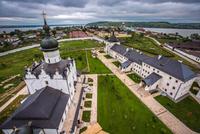You are in: Europe -> Russia -> Assumption Cathedral... , and traditional search or Image Gallery will yield results of this site only
Assumption Cathedral and Monastery of the town-island of Sviyazhsk
| Site number: | 1525 |
|
| Type of site: | Cultural | |
| Date: | 16th century | |
| Date of Inscription: | 2017 | |
| Location: | Europe, Russia, Sviyazhsk | |
Up to 75 images are shown here. Click on each for more details or on Image Gallery for more images.
| Description: | The Assumption Cathedral is located in the town-island of Sviyazhsk and is part of the monastery of the same name. Situated at the confluence of the Volga, the Sviyaga and the Shchuka rivers, at the crossroads of the Silk and Volga routes, Sviyazhsk was founded by Ivan the Terrible in 1551. It was from this outpost that he initiated the conquest of the Kazan Khanate. The Assumption Monastery illustrates in its location and architectural composition the political and missionary programme developed by Tsar Ivan IV to extend the Moscow state. The cathedral’s frescoes are among the rarest examples of Eastern Orthodox mural paintings. --WHMNet's description is from WHC Site, where additional information is available.CC BY-SA 3.0. | |
| Sviyazhsk (Russian: Свия́жск; Tatar: Зөя, Zöyä) is a rural locality (a selo) in the Republic of Tatarstan, Russia, located at the confluence of the Volga and Sviyaga Rivers. It is often referred to as an island since the construction of the Kuybyshev Reservoir at Tolyatti downstream Volga in 1955, but it is in fact connected to the mainland by a road. Sviyazhsk was founded in 1551 as a fortress, which was built within four weeks from parts made in Uglich and transported down the Volga. It became a military base of the Russian army during the siege of Kazan (1552). --Wikipedia. Text is available under the Creative Commons Attribution-ShareAlike License. CC BY-SA 3.0. |
||
| Source: | http://whc.unesco.org/en/list/1525. Description is available under license. CC-BY-SA IGO 3.0. | |
| Source2: | Wikipedia (http://wikipedia.com). CC BY-SA 3.0. | |
| Reference: | 1. UNESCO World Heritage Center (http://whc.unesco.org/en/list/1525). 2. Wikipedia. CC-BY-SA IGO 3.0. | |






